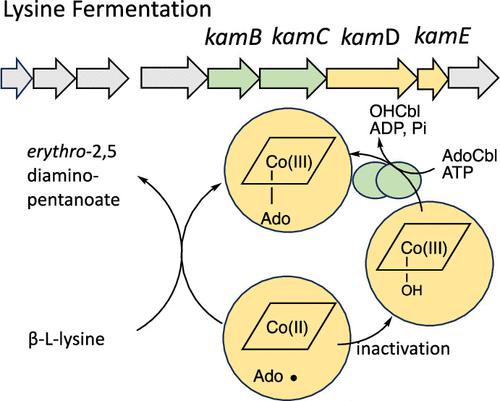当前位置:
X-MOL 学术
›
Biochemistry
›
论文详情
Our official English website, www.x-mol.net, welcomes your feedback! (Note: you will need to create a separate account there.)
Characterization of a Structurally Distinct ATP-Dependent Reactivating Factor of Adenosylcobalamin-Dependent Lysine 5,6-Aminomutase
Biochemistry ( IF 2.9 ) Pub Date : 2024-03-12 , DOI: 10.1021/acs.biochem.3c00653 Amanda L. Darbyshire 1 , Kirsten R. Wolthers 1
Biochemistry ( IF 2.9 ) Pub Date : 2024-03-12 , DOI: 10.1021/acs.biochem.3c00653 Amanda L. Darbyshire 1 , Kirsten R. Wolthers 1
Affiliation

|
Several anaerobic bacterial species, including the Gram-negative oral bacterium Fusobacterium nucleatum, ferment lysine to produce butyrate, acetate, and ammonia. The second step of the metabolic pathway─isomerization of β-l-lysine to erythro-3,5-diaminohexanoate─is catalyzed by the adenosylcobalamin (AdoCbl) and pyridoxal 5′-phosphate (PLP)-dependent enzyme, lysine 5,6-aminomutase (5,6-LAM). Similar to other AdoCbl-dependent enzymes, 5,6-LAM undergoes mechanism-based inactivation due to loss of the AdoCbl 5′-deoxyadenosyl moiety and oxidation of the cob(II)alamin intermediate to hydroxocob(III)alamin. Herein, we identified kamB and kamC, two genes responsible for ATP-dependent reactivation of 5,6-LAM. KamB and KamC, which are encoded upstream of the genes corresponding to α and β subunits of 5,6-LAM (kamD and kamE), co-purified following coexpression of the genes in Escherichia coli. KamBC exhibited a basal level of ATP-hydrolyzing activity that was increased 35% in a reaction mixture that facilitated 5,6-LAM turnover with β-l-lysine or d,l-lysine. Ultraviolet–visible (UV–vis) spectroscopic studies performed under anaerobic conditions revealed that KamBC in the presence of ATP/Mg2+ increased the steady-state concentration of the cob(II)alamin intermediate in the presence of excess β-l-lysine. Using a coupled UV–visible spectroscopic assay, we show that KamBC is able to reactivate 5,6-LAM through exchange of the damaged hydroxocob(III)alamin for AdoCbl. KamBC is also specific for 5,6-LAM as it had no effect on the rate of substrate-induced inactivation of the homologue, ornithine 4,5-aminomutase. Based on sequence homology, KamBC is structurally distinct from previously characterized B12 chaperones and reactivases, and correspondingly adds to the list of proteins that have evolved to maintain the cellular activity of B12 enzymes.
更新日期:2024-03-12



























 京公网安备 11010802027423号
京公网安备 11010802027423号